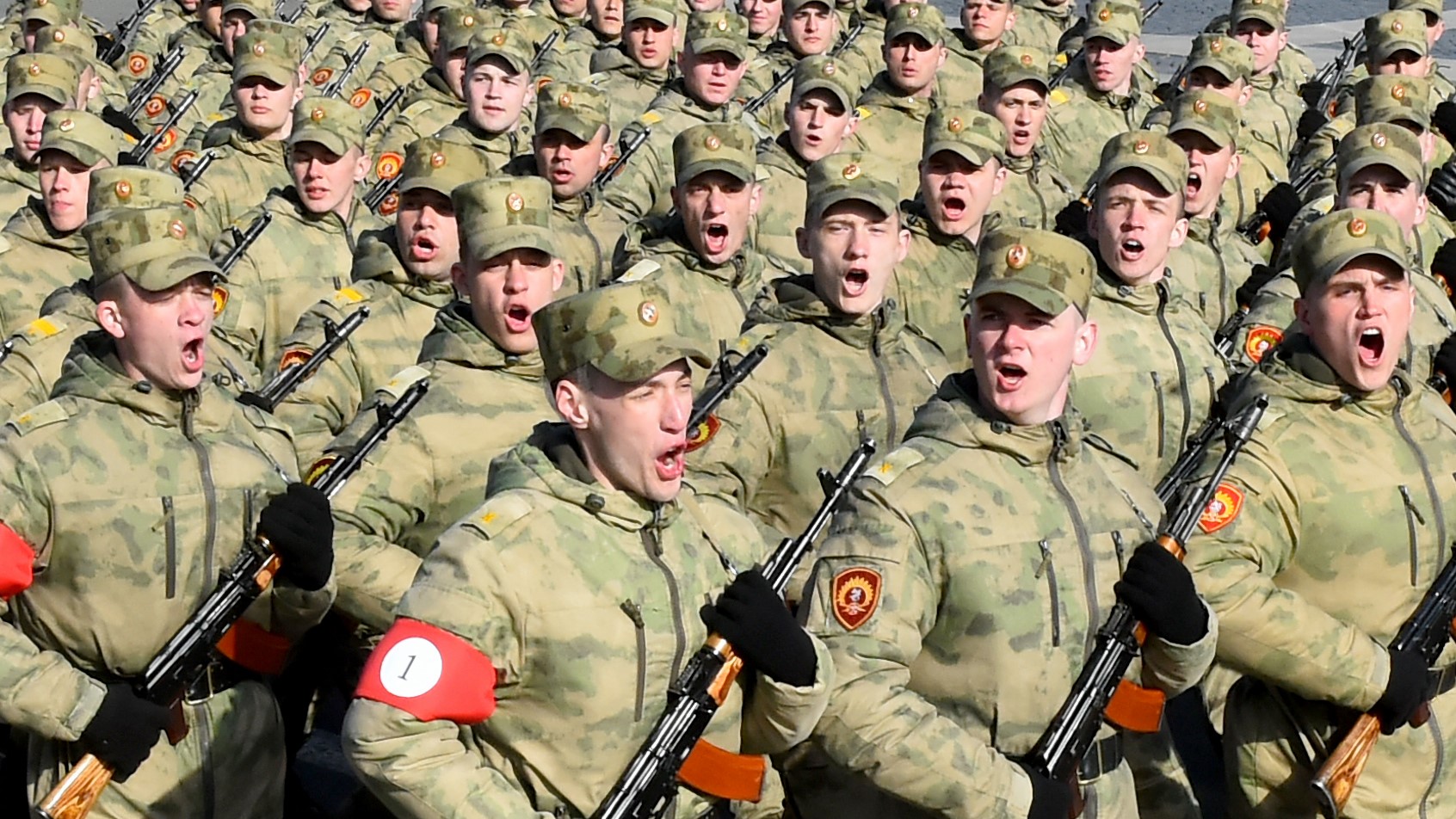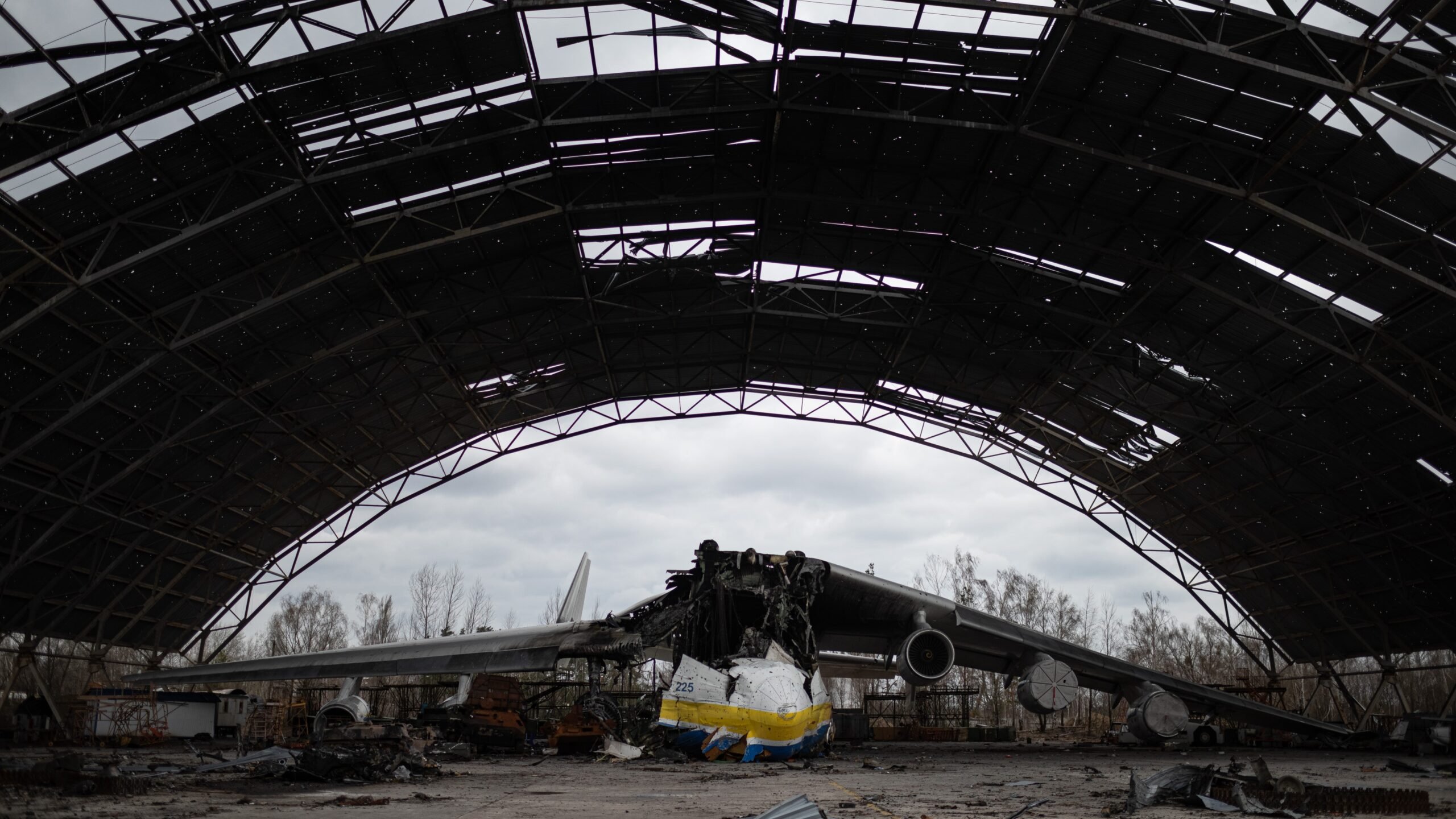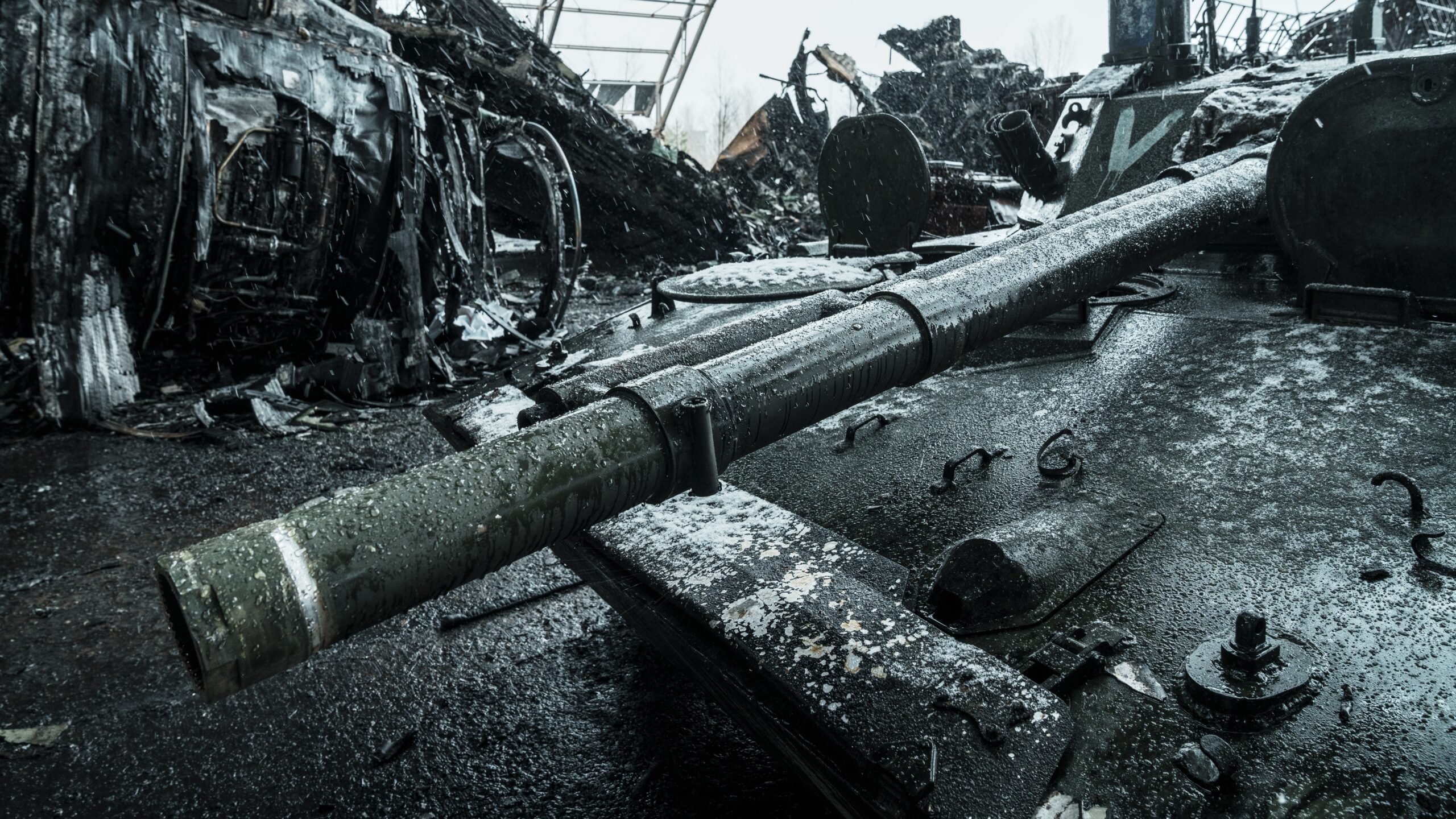
Russian military cadets take part in a rehearsal for the Victory Day military parade on Dvortsovaya Square in Saint Petersburg on April 28, 2022. (OLGA MALTSEVA/AFP via Getty Images)
Editor’s Note: On March 4, just hours after filing an on-the-ground assessment of the first few weeks of the Russian invasion of Ukraine, Kyiv-based Breaking Defense contributor Reuben Johnson disappeared. He eventually remerged in Poland, having been robbed by Russian soldiers and detained at gunpoint for two full weeks. The following is Reuben’s story of his time in captivity at a Russian base, how he eventually was freed and what he learned about the invasion while surrounded by Russian soldiers.
FORT LAUDERDALE, FLA.: Sitting 12 floors above the beach and looking out at the Atlantic Ocean, it is hard to believe that a few weeks ago I was a prisoner of the Russian army. It’s hard to believe that today I am somehow still alive.
The story begins on March 4, when my partner and I decided to head for a rail station to catch an evacuation train out of the country. While near the Ukrainian towns of Irpin and Bucha, near Kyiv, our car was ambushed by a Russian army unit. These were soldiers purposely hiding out of sight from anyone traveling down the road, looking for the perfect, defenseless vehicle to ambush. Before we could register what was happening, the car was being riddled by machine gun fire; by some miracle the three of us in the car all survived the many bullets that penetrated the chassis and shattered the windows.
After the initial hail of bullets, we all jumped out and fled the vehicle, which then rolled backwards down a hill and smashed into a fence at the bottom. The Russian soldiers — not bothering to check who we were or if we were alive or dead or wounded — pounced on the remains of the car and ripped apart our backpacks and suitcases while two or three or their number ordered us out of the shelter we had fled to.
In a preview of the barbaric behavior that the Russian army has become famous for, they held us at gunpoint, would not permit us access to our own belongings in our vehicle, and proceeded to steal everything they could get their hands on: money I was carrying for my son’s education, computers, hard drives, all of our iPhones, sunglasses, perfume, clothing.
They even stole a gold ring off my hand that I had owned for 25 years and had planned to gift to my son at his graduation this May.
While the driver we had hired was temporarily detained and then released, my partner and I were first taken to the middle of a forest near Kyiv for one night. The next day we were transported to an underground bunker and confined to a filthy, excessively damp room with no running water, toilet, or heat.
That hole would be our home for our two week ordeal. We had no contact with the outside world and thus no direct information that Moscow’s invasion of Ukraine was consistently failing to meet any of its operational objectives. We also had no sense of what our fate would be.
RELATED: As battle for Ukraine enters a new phase, so does lethal US aid
In some ways, the ignorance was a good thing. We were not aware of the international war crimes horror show that was unfolding elsewhere in the country. But even during our captivity and subsequent, still mysterious freedom, there were signs of what was to come.
And the time we spent in the hole also gave plenty of indirect clues that the invasion of Ukraine had turned into a humiliating spectacle. Along the lines of the proverbial “gang that couldn’t shoot straight,” Russian President Vladimir Putin’s original timetable for instant victory about which the Kremlin had boasted loudly before it sent its legions across the border was turning into one embarrassing battlefield debacle after another, and the soldiers in the bunker with us knew it.
But what was happening in the outside world didn’t matter to us in our new home. Two weeks. Over 300 hours — and every one of those hours we were awake we were joined by a guard sitting in the corner with an AK-47, leaving us wondering if today was the day that gun would be turned on us.
Underground At Gostomel
This underground bunker was on the grounds of Gostomel Airport, just outside of Kyiv. For many years the aerodrome has been the base of operations for the Antonov aircraft company’s cargo airline. It was also famous for being the home of the single existing flying model of the world’s largest airplane, the six-engine An-225 Mriya.
This unique aircraft was destroyed in the very first days after the 24 February initial attacks by the Russian armed forces (VSRF). Estimates as to what would be required to restore this piece of aviation history to flying condition range from $350 to $500 million USD, but that may not be realistic. An experienced Antonov engineer told CNN “it’s impossible to talk about the repair or restoration of this aircraft — we can only talk about the construction of another Mriya, using individual components that can be salvaged from the wreckage and combining them with those that were, back in the 1980s, intended for the construction of a second aircraft.”

The remains of Johnson’s car, after the Russian ambush, accessed via cloud. (Reuben Johnson)
How the An-225 was destroyed despite being parked off in its own special hangar and away from the main runways was easy to see from the first day of being incarcerated. The Russian military had attempted to take control of Gostomel on Feb. 24 in order to use the runways to bring in additional invasion forces. But like every other battle fought by the Russians, shelling and use of heavy weapons had been indiscriminate and needlessly destructive rather than precise and targeted.
Russian intelligence had also badly underestimated the size of the Ukrainian forces defending the airport and saw their initial assault units driven out in what has been characterized as the “Russian Airborne Disaster.” This sparked a pitched battle for the airport, with the Ukrainian side fighting for control for the facility, which damaged the runways to the point where they were unusable.
The destruction of the Mriya and the overall devastation of the airport were clear to see when I was brought to the facility, before being blindfolded and led into the underground bunker where I would end up spending many days.
The failure to capture the airport intact was emblematic of the Moscow’s inability to fulfil a single major requirement of the war plan they had declared at the outset of the invasion. By the time I was taken into the Gostomel facility, the war that was supposed to be over by the end of February was now well into March and had become a conflict of double-digits in length. Not a single major city had been taken by the Russian military. Russian casualties and losses of equipment were surpassing any of the most pessimistic initial estimates.
We were never actually permitted to see what took place outside of the room we were held in. We could, however, hear a great deal. The rooms across the corridor were a communications center that received radio and field telephone transmissions all day long. The electronic musical tones that signaled an incoming message were like the alarm clock in the morning that told us the working day in this bunker we were confined to had begun.
On the other side of the room, however, we would hear the disturbing sounds of screaming and sometimes endless delirious babbling of injured soldiers. The Russians were using this area as a triage center to patch up their wounded and make them transportable before being sent off to a proper field hospital. We would also hear a large role of packaging tape being unwound on a tape gun — the sound associated with packing a deceased soldier into a body bag.
We eventually established a rapport with the soldiers guarding us, as well as with the medical staff that was treating me for hypertension. Their demeanor was distinctly different from that of their brainwashed command staff. Most of them were young and had never been outside of Russia in their lives. The invasion of Ukraine was their first “trip abroad” and not one that many of them appeared to enjoy.
After some days they began to admit that before they left Russia they had all been told some variation of the same message: “We would be in Ukraine a maximum of four to five days and then Ukraine would be conquered, and we would go home.”
But as the conflict stretched into the second half of March it became obvious to these soldiers that no one was going home again anytime soon. Meanwhile, they were cut off from all contact with their families. Unlike some of the marauding and murdering troops in the field who were ringing to tell people in Russia how many Ukrainians they had raped and/or murdered, these soldiers had no mobile phones and no way to make contact back home.

The destroyed Ukrainian Antonov An-225 “Mriya” cargo aircraft is seen among the wreckage of Russian military vehicles at Gostomel airfield on April 8, 2022. Johnson was kept prisoner at the airfield. (Alexey Furman/Getty Images)
The clearest sign the Ukrainian military was not the pushover that Russian soldiers had been led to believe was that life above this underground shelter on the surface of the airport grounds was a scene of constant shelling. Bombardments — both sparse, two or three rounds of “shoot and scoot” mortar attacks and sustained, concentrated artillery barrages — took place at all hours of the day.
At some points even small arms fire could be heard — indicating that Ukrainian forces attacking the airport were nearly on top of us. During one particular attack targeting the bunker where I was held, the guards in the room were even issued an extra set of body armor. It was as if the Russians expected that Gostomel Airport and this bunker would be overrun by the Ukrainian military and there would be literally room-to-room fighting inside the corridors.
Through this two week ordeal, we were told several times that our release was being organized — a pledge that felt like false hope at best. Nothing of what we had been told from the moment we were taken captive ever turned out to be true. When days would then pass with no word of our being taken to some kind of a humanitarian corridor, we assumed this was either more of the Russian army’s rampant unprofessionalism or just some kind of sick psychological warfare.
Then unexpectedly, 14 days after our kidnapping, two soldiers came and told us we were being released and we had to leave — now. When we asked about the personal items that we had been told would be returned to us, the soldiers said that “maybe they can be sent in another vehicle to the place where you will be released.” It will shock no one that we never saw our belongings again.
After being driven 40 minutes to another building outside of the area of Gostomel, we were left to sleep on metal chairs all night long. We were convinced that at some point we would be told we were being taken to prison in Russia or sent to some interrogation center, but the reality ended up being just as chaotic and unorganized as Russia’s entire invasion. A four-hour drive — through the Chernobyl radiation zone, no less — and then we were dropped unceremoniously by the side of the road. A soldier pointed and said, “Belarus is that way — you should start walking.”
So we started walking. From the Belarus border (and after endless questioning by Belarussian forces about what had happened to us in Ukraine) we were taken to the Red Cross. They then transported us to a sanatorium in Gomel, the second-largest city in Belarus, where we had our first shower in two weeks. The next day we took a train to Brest, on the border with Poland, and then across to Terespol in Poland where we boarded a bus for Warsaw.
For a few weeks we lived on the generosity of our Polish friends, as we tried our best to reconstruct our lives and come to grips with what had happened, both to us personally and to the country I have called home for decades. Eventually, we decided to return to the US. We were never told why we were released — although we later discovered that many people were working behind the scenes to make that happen.
In that regard, we were the lucky ones; we now know that thousands of Ukrainians are being deported to Russia as de facto hostages, and an unknown number of civilians lie in mass graves, the victims of Russia’s horrific war crimes. Their stories may never be told, thanks to the bloody, monstrous actions of Putin and his ilk.
Why The Invasion Continues to be a Failure
Even before my detainment one could see the seeds of the Russians’ lack of success currently unfolding in almost every major aspect of this conflict. But after spending two weeks with Russian forces, a few points became clear.
Unrealistic Expectations: To a man, Russian military personnel I talked to all stated that they had been told “the Ukrainians will fold, surrender their positions and you would be back home before you know it.” But, as the days dragged on, it became obvious to these Russians that their superiors who gave them these rosy predictions had no concept of what the Ukrainians’ true capabilities were.
This resulted in a situation where the war has become a protracted struggle and is having increasingly negative effects on the Russians’ unit cohesion and combat effectiveness.
Unbeknownst to me, there were plenty of signs of this appearing in the surface world. One Russian tank commander, identified in the Ukrainian press only by his nickname of “Misha,” told the Ukrainians he handed his tank over to them as “his tank crew mates had fled home, leaving him behind. He saw no point in continuing to fight,” said the Ukrainian military source quoted by the Ukrainian state information service.
The same Russian soldier also told the Ukrainians that he could not return home because “his commander threatened to shoot him and write him off as combat loss.” He also stated that Russian units “were practically out of food stocks, while the management of their unit was chaotic and almost non-existent. Demoralization levels are enormous.”
Not surprisingly, conditions became so dismal that another Russian unit mutinied, ran over the legs of their commanding officer with one of their tanks and left him to bleed out and die..

Wreckage of Russian military vehicles near the destroyed Ukrainian Antonov An-225 Mriya cargo aircraft. (Serhii Mykhalchuk/Global Images Ukraine via Getty Images)
No Rational Or Defined Objectives: This dismal set of conditions is exacerbated by the Russian side being unable to set any rational, real-world objectives for their unprovoked and unjustified invasion of Ukraine. While in captivity my own experience was that, while the lower-level soldiers were open about their confusion and concerns, trying to engage the senior officer in charge of the men stationed in this bunker in a discussion of what this war was about was an exercise in futility.
Even suggesting that those nations sanctioning Moscow and supplying Ukraine with weapons were acts taken against Putin as a result of the invasion would elicit a prolonged, angry outburst. These fits of rage seemed more a product of brainwashing than professional military man’s intelligence-based assessment. The script was always the same: a repeat of the same litany of personal and political grievances that the Russian president has become famous for in his interactions with world leaders like French President Emmanuel Macron.
The sum total of the party line justifying the invasion: the entire world has been against Russia and for centuries there is not a single nation which has not caused harm to the nation and its people. Therefore, it has become necessary to “demilitarize and de-Nazify Ukraine” in order to prevent “genocide by the Kyiv regime.” (This pretzel logic justification conveniently ignores that the democratically elected Ukrainian president, Volodymyr Zelensky, is Jewish and that several of his relatives perished in the Holocaust.)
RELATED: A long guerrilla war is likely in Ukraine. The US must plan to help.
Putin’s claims of a Ukrainian Nazi government being guilty of genocide have been condemned by none other than José Casanova, a professor emeritus of sociology at Georgetown University. Russian propagandists are cynically attempting to discredit Ukrainian independence and expressions of their own national identity by labelling them as Nazism, he explained.
“Every time the Ukrainians try to establish a democratic society, they try to say that those are Nazis,” he told NPR. “You need to dehumanize the other [side] before you are going to murder them, and this is what’s happening now.”
Logistical and Command Failures: Shortages of fuel, ammunition and food stocks were being reported even in the early days of the invasion, but little has been done to address these deficiencies. Some of this has been documented from the early days of the war, but one could see at the ground level from the facility at Gostomel where I was held that the Russian military had crossed into Ukraine neither prepared nor equipped for either the level of resistance the Ukrainians were presenting or the duration of the conflict.
Our truck ride towards Belarus as telling in terms of the problems the Russian military was having. This was in the second half of March and supplies of essential items like petrol were still problematic. The small group of vehicles trailing behind the truck I was in was even forced to stop more than once to allow long columns of fuel tanker lorries and other supply vehicles that were racing south in the opposite direction towards Kyiv to pass by.
At the opposite end of the chain of command, there has been nothing but uninspired leadership from the VSRF’s upper ranks. Ukrainian strikes on Russian command posts have killed 10 generals so far, along with a host of other senior officers. Russia’s military seems to have forgotten the lessons it learned about the vulnerability of command posts in the field in its initial invasion of Ukraine’s Donbas in 2014, with the result that these decapitation strikes are occurring with regularity.
Lack of Discipline: George Washington once said, “Nothing can be more hurtful to the service, than the neglect of discipline; for that discipline, more than numbers, gives one army the superiority over another.” Not surprisingly, it is a near-total lack of discipline that has turned the Russian army into a fallen giant.
By way of example, one of the many accounts that appeared after our release when the Russians had receded from the area near Bucha were that some of the Ukrainian civilians who ended up in mass graves were those shot while simply pedalling a bicycle down the street. As we were being driven to Gostomel, we saw with our own eyes persons on bicycles being shot at, as well as a host of other criminal acts.
Russian veterans of the Afghan war who were interviewed recently pointed out that the looting, rape and murder of the civilian population by Moscow’s soldiers in Ukraine are indications of an army has lost all semblance of a disciplined structure and has no robust non-commissioned officer corps to maintain it. It is also the sign of an army “that already suspects it has lost.”
The active-duty and retired NATO officers I have spoken to in recent weeks about the seemingly endless uncovering of war crimes in Ukraine have had probably the harshest words I have ever heard spoken about what was supposed to be the military establishment of a modern, industrial state.
Their sentiments to a man are that this rabble of a Russian army is nothing for the US and its NATO partners to be afraid of any longer. Should NATO intervene in Ukraine, they say, what is left of the Russian army would be mopped up in short order. (Of course, NATO nations are hesitant to do that over concerns it would trigger a nuclear response from Putin; his finger on the nuclear button remains the only true military threat to the West at this point.)
RELATED: Russia has a military professionalism problem, and it is costing them in Ukraine
Even if NATO troops do not enter Ukraine, it is not clear what resources Russia has left to commit to its Ukraine invasion. US intelligence estimates are that 75% or more of Moscow’s military is already committed to this operation, with military forces across Russia’s giant land mass largely stripped to the studs to support the Ukraine effort.
This became readily visible earlier in April when Finland announced plans to consider NATO membership. Immediate reports were that Russia was moving military units to its border with Finland in order to try and intimidate Helsinki. But a close look at those units revealed some of the vehicles to be the K-300P Bastion-P coastal/anti-ship defense missile system. These missiles would be of no use in a conflict with Finland, as there are no bodies of water or Finnish naval vessels deployed on the border between the two nations.
Speaking to Breaking Defense, a former Swedish defense official said that “these anti-ship missiles were sent to try and ‘frighten’ the Finns because these are about the only mobile missile launchers that are painted green that Putin has on hand to send anywhere. Everything else is already in Ukraine. There is not now, nor is there likely to be in the future, much of a Russian military left after this current conflict is over with.”
We now know that the Russian invasion of Ukraine has turned into one of the most colossal miscalculations in the history of modern warfare. Expectations for a “successful” prosecution of the war have been steadily declining over the period of the last two months. The definition of victory now amounts to Putin’s military being able to accomplish little more than expand the area under its control in Eastern Donbas.
This is the same region which it has laid waste to and occupied since the summer of 2014. If the international coalition supporting Ukraine can hold together long enough, even these modest goals may remain out of reach.
Whatever insights I may have gained from my two weeks of captivity weren’t worth the nightmares and memories I’ll never quite get rid of. But they did give me a chance to understand the reality for Russian forces on the ground. And the reality is this: the invasion has been nothing short of a disaster, and the only way out is for Ukraine to continue to roll back Moscow’s ambitions.
I can’t wait to go back to my home in Kyiv when victory — whatever it may look like — is achieved.
Connecticut lawmakers to grill Army, Lockheed about job cuts at Sikorsky helicopter unit
“The Connecticut delegation has questions about why, with that [FY24] appropriation in hand, this happened,” said Rep. Joe Courtney, D-Conn.


























